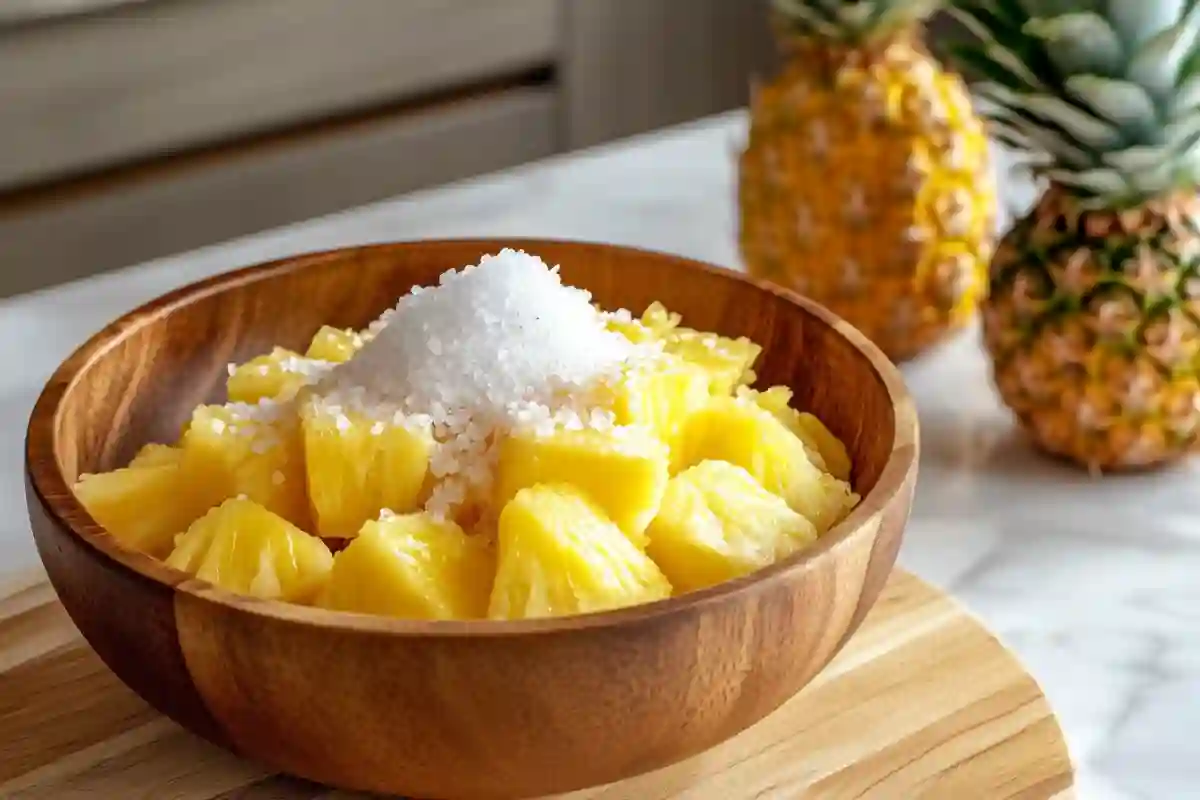Sweetness Amplification: Salt enhances the perception of sweetness by suppressing bitterness. Pineapples often have trace bitterness or high acidity, and salt masks these elements, making the fruit taste sweeter and more flavorful.
Flavor Complexity: Salt activates taste buds that heighten savory flavors, adding depth and making the pineapple’s sweetness feel more robust.
Acidity Balance: The natural tanginess of pineapple can be intense. Salt reduces sharp acidic notes, creating a more mellow and balanced flavor.
Enhanced Sweetness: Even a slightly sour or under-ripe pineapple tastes sweeter with salt.
Balanced Acidity: Salt tames the fruit’s tang, allowing you to savor the rich tropical sweetness.
Flavor Contrast: The interplay between salty and sweet flavors creates a dynamic and satisfying taste experience.
Introduction
1. Enhancing Sweetness and Complexity
- Flavor Science: Salt suppresses bitter flavors while intensifying sweetness. Pineapples, with their natural combination of sugars and acidity, become sweeter and more nuanced when lightly salted.
- Taste Layers: Adding salt adds depth to the fruit, making it not just sweet but also richly complex with a hint of savoriness.
2. Balancing Tartness
- Pineapples are known for their vibrant tartness, which can sometimes feel overwhelming. Salt helps neutralize this sharpness, creating a smoother and more harmonious flavor.
- The result is a well-rounded taste where sweetness takes center stage, enhanced by a subtle savory undertone.
3. A Practice Rooted in Tradition
- Global Appeal: Cultures around the world have long used salt to complement the natural sweetness of fruits. From Thailand’s fruit dips to Mexico’s chili-salt blends, salted pineapple is a global favorite.
- Timeless Trick: This simple method has stood the test of time, becoming a beloved way to enjoy pineapple in both everyday snacks and gourmet dishes.
4. A Fascinating Experience for the Curious Palate
- For those who enjoy exploring new flavors, salted pineapple offers a delightful surprise. The contrast of sweet and salty flavors creates an exciting and memorable taste experience.
- It’s a perfect introduction to the broader world of seasoning fruits for enhanced flavor.
5. A Simple Trick With Big Impact
Versatile: Enjoy salted pineapple on its own, or use it as an ingredient in salads, salsas, or tropical beverages for added flavor complexity.
Effortless: All it takes is a sprinkle of salt to transform your pineapple from ordinary to extraordinary.
Why do you rub salt on pineapple? Flavor Science and Sensory Effects
Why do you rub salt on pineapple? The answer lies in flavor chemistry. Salt influences how our tongues perceive sweetness and acidity. Therefore, when you sprinkle a pinch of salt on ripe pineapple, the overall taste changes. Moreover, salt reduces bitterness and allows sweetness to shine. Basically, it encourages your palate to focus on the fruit’s sweet notes. Comparatively, salted pineapple often feels juicier, leaving an unforgettable impression.
Why do you rub salt on pineapple? Pineapple’s Natural Acidity and Sweetness
Pineapple combines tangy acidity and sugary sweetness. However, adding salt draws attention to the sugar, making each bite taste sweeter. Another bonus: salt diminishes any underlying bitterness. Consequently, salted pineapple seems more balanced and appealing. Particularly, this trick elevates even less-than-perfect fruit into a more enjoyable snack.
Enhancing Pineapple’s Complexity with Salt
Salt creates depth by amplifying certain taste receptors. It also releases aromatic compounds trapped in the fruit’s fibers. Accordingly, salted pineapple often tastes more fragrant. Additionally, the overall flavor profile becomes richer. Thus, a simple pinch of salt can transform a familiar fruit into something more intriguing.
Salt and Mouthfeel
Salt not only affects flavor but also mouthfeel. For example, salted pineapple may feel juicier because salt stimulates saliva flow. Indeed, extra saliva helps break down fruit fibers, releasing more juice. Consequently, this leads to a pleasant, refreshing texture. In essence, sprinkling a bit of salt upgrades both taste and tactile experience.

Why do you rub salt on pineapple? Cultural and Traditional Practices
Many cultures incorporate salting pineapple into their culinary customs. Why do you rub salt on pineapple? In some places, it’s a long-standing tradition.
Why do you rub salt on pineapple? Latin American Traditions
Street vendors in Latin America often serve pineapple sprinkled with salt and chili. Essentially, they discovered that salt intensifies sweetness and pairs well with spice. Furthermore, this snack cools you down in hot climates. Eventually, it became a favorite treat. Even travelers embrace this local habit, excitedly tasting salted pineapple on bustling streets.
Asian Influences
In parts of Asia, pairing fresh fruit with savory elements is common. Consequently, pineapple with a hint of salt appears in various dishes. Moreover, markets offer salted fruit snacks to shoppers seeking flavorful refreshments. Indeed, these customs show that enhancing fruit’s taste with salt is a global practice.
Hawaiian and Pacific Island Customs
Tropical islands, like Hawaii, feature abundant pineapple harvests. Adding salt to sliced pineapple, especially at luau feasts, adds a special twist. Basically, locals have long recognized how salt boosts pineapple’s flavor. Tourists learn this tip and share it, spreading the tradition worldwide.
Why do you rub salt on pineapple? Health and Nutrition Considerations
Pineapple boasts plenty of nutrients, but salt intake matters too. Keeping balance ensures that salted pineapple remains both tasty and healthy.
Nutritional Benefits of Pineapple
Pineapple provides vitamin C for immunity, manganese for metabolism, and bromelain for digestion. Additionally, it contains fiber and other beneficial compounds. Because of these nutrients, pineapple supports overall health. Adding a small amount of salt won’t erase these benefits.
Sodium Intake and Moderation – Why do you rub salt on pineapple?
Salted pineapple tastes great, but sodium intake should remain moderate. However, a light sprinkling rarely poses a serious health risk. Nonetheless, individuals watching their sodium levels should be cautious. Basically, use a small pinch and savor the result. Consequently, you enjoy the flavor boost without surpassing recommended sodium guidelines.
Balancing Flavors and Dietary Needs
If you prefer less sodium, consider sea salt or reduced-sodium blends. Likewise, adjust the quantity according to taste. For example, just a few grains can enhance sweetness. Undoubtedly, salted pineapple can fit into various diets, provided you remain mindful. Eventually, personal preference guides how much salt to add.
Why do you rub salt on pineapple? Selecting and Preparing Pineapple for Salting
Preparation matters. Choosing a ripe pineapple and using the right technique ensure optimal results.
Choosing the Right Pineapple – Why do you rub salt on pineapple?
Selecting a ripe, sweet pineapple is key. Look for bright, firm skin with a slight give. Basically, the fruit should smell fragrant at the stem end. Indeed, a well-chosen pineapple responds beautifully to a pinch of salt. If the pineapple is too green, its flavor might be flat, even with added salt.
Cutting and Prepping the Fruit
First, remove the pineapple’s top and bottom. Next, trim off the skin and dig out the “eyes.” Then slice or cube the fruit into bite-sized pieces. Because smaller pieces allow salt to distribute evenly, you get consistent flavor. Afterward, you have a perfect canvas for your salty sprinkle.
Proper Salting Techniques
Sprinkle a tiny pinch of salt, then wait a moment. Let it dissolve and interact with the pineapple’s juices. Comparatively, adding too much salt at once can overpower. Therefore, start small and add more if needed. Equally, experiment with different types of salt. A pinch of flaky sea salt, for instance, can create an appealing crunchy accent.
Why do you rub salt on pineapple? Creative Uses for Salted Pineapple
Salted pineapple shines as a snack, but its uses extend beyond basic munching. Incorporating salted pineapple into various recipes elevates your culinary repertoire.
Snack Ideas and Simple Treats – Why do you rub salt on pineapple?
A bowl of salted pineapple chunks makes a quick, refreshing snack. Another idea: squeeze fresh lime juice over salted pineapple for extra zing. Likewise, pair salted pineapple with a dollop of yogurt or a handful of nuts. Ultimately, these simple twists create fun, nutritious treats.
Recipes and Culinary Applications
In salads, salted pineapple pairs well with leafy greens, cucumbers, and herbs. Additionally, grilling pineapple brings out caramel notes, and a sprinkle of salt intensifies them further. Consider topping tacos or ceviche with salted pineapple salsa. Undoubtedly, the possibilities go far beyond plain fruit bowls.
Beverages and Cocktails
Bartenders sometimes use salted pineapple as a cocktail garnish. Indeed, the contrast of sweet, salty, and sour notes elevates mixed drinks. Non-alcoholic beverages, like smoothies, also benefit from a pinch of salt. Essentially, salted pineapple can inspire new creations, making ordinary drinks taste extraordinary.
Why do you rub salt on pineapple? Common Mistakes and How to Avoid Them
While salting pineapple is simple, a few pitfalls can compromise the experience. Paying attention helps you avoid these mistakes.
Over-Salting the Fruit – Why do you rub salt on pineapple?
Too much salt ruins the experience. However, this mistake is easy to fix. Rinse the fruit briefly or add more unsalted pineapple to dilute the saltiness. Next time, start with less salt. Gradually adjust until you find the perfect balance.
Using the Wrong Type of Salt
Table salt works, but finer sea salt or kosher salt distributes more evenly. Furthermore, these salts often have subtler flavors. Choosing a higher-quality salt enhances the final taste. Thus, the type of salt matters.
Not Considering Other Ingredients
When adding salted pineapple to recipes, think about other flavors involved. For example, if the dish already contains salty ingredients, use less salt on the fruit. Similarly, ensure that sweetness, acidity, and salt remain balanced. Eventually, practice helps you achieve flawless harmony.
Frequently Asked Questions (FAQ)
Q: How much salt should I use on my pineapple?
A: Start with a small pinch. Taste, then add more if needed. Moderation ensures a balanced, sweet-salty flavor.
Q: Does salting pineapple make it healthier?
A: Not necessarily. Adding salt does not increase nutrients. It only enhances taste. Pineapple is already nutritious, so salt’s main role is flavor.
Q: Is salted pineapple common in certain cuisines?
A: Yes, especially in Latin America and some Asian regions. Street vendors and home cooks often sprinkle salt on pineapple for a refreshing treat.
Q: Can I use flavored salts on pineapple?
A: Absolutely. Infused salts, like chili-lime or smoked salts, add extra complexity. Try different varieties to find your favorite.
Q: Does salt help if the pineapple is not ripe?
A: Salt can slightly improve flavor, but it cannot fix a very unripe pineapple. Choose ripe, fragrant fruit for the best results.
Conclusion : Why do you rub salt on pineapple?
1. Intensifies Sweetness Through Science
Flavor Perception: Salt enhances the perception of sweetness by suppressing bitterness. Pineapples naturally contain a balance of sugars and organic acids. When salt is added, it masks any residual bitterness, allowing the fruit’s natural sweetness to shine more brightly.
Ion Interaction: Salt ions interact with taste buds, amplifying sweet receptors. This is why even a mildly sour or under-ripe pineapple can taste sweeter with a touch of salt.
2. Balances Acidity
Pineapples are rich in citric acid, which gives them their tangy flavor. For some, this acidity can be overpowering. Salt neutralizes the sharpness of the acid, creating a smoother and more harmonious flavor profile.
This balance is particularly appreciated in regions where the fruit’s tartness is considered too strong without modification.
3. Adds Complexity to Flavor
The addition of salt introduces a savory dimension, creating a contrast that makes the overall taste more dynamic. This interplay of sweet, salty, and tangy notes elevates the fruit from simple to gourmet.
4. Cultural Significance
Many cultures embrace the practice of salting fruits, including pineapples, to enhance flavor. In countries like Thailand, Mexico, and the Philippines, salt is often paired with chili powder or lime for a zesty combination.
These traditions highlight the universal appeal of combining salt with sweet fruits, showcasing the technique as a timeless culinary trick.
Related Article : Pineapple Casserole: The Perfect Sweet and Savory Delight

